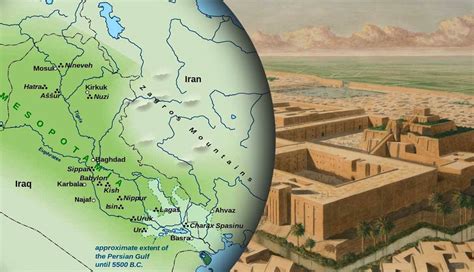Mesopotamia, a region in the Middle East, is widely regarded as the cultural hearth of human civilization. This fertile land, nestled between the Tigris and Euphrates rivers, witnessed the emergence of some of the world’s earliest and most influential societies.

Geography and Environment
Mesopotamia’s geographical location played a pivotal role in its cultural development:
- Fertile Soil: The region’s rich alluvial soil, deposited by the annual flooding of the Tigris and Euphrates, provided ideal conditions for agriculture, supporting large and stable populations.
- Abundant Water: The two rivers ensured a reliable water supply for irrigation, drinking, and transportation.
- Natural Barriers: The surrounding deserts and mountains acted as natural barriers, protecting Mesopotamia from invasions and fostering a sense of isolation.
Urbanization and Innovation
Around 4000 BCE, Mesopotamia experienced a surge in urbanization. Cities such as Uruk, Eridu, and Ur emerged as centers of power, trade, and innovation. These urban centers gave rise to the following breakthroughs:
- Cuneiform Writing: Developed in Uruk, cuneiform became the first known form of written language. It was used for record-keeping, administration, and literary compositions.
- Monumental Architecture: The Sumerians built impressive temples and palaces, such as the Ziggurat of Ur, which demonstrated their architectural prowess and religious beliefs.
- Advanced Irrigation: Mesopotamians devised sophisticated irrigation systems to maximize land use and increase agricultural productivity.
- Metalworking and Metallurgy: They excelled in metalworking, producing bronze, copper, and gold objects, including tools, weapons, and ornaments.
Society and Culture
Mesopotamian societies were highly structured and complex:
- Social Hierarchy: Society was divided into classes, with the king or emperor at the apex, followed by the ruling class, priests, commoners, and slaves.
- Religion: The Mesopotamians practiced polytheism, believing in multiple gods and goddesses associated with natural elements and celestial phenomena.
- Literature: Mesopotamia produced some of the world’s earliest written literature, including the Epic of Gilgamesh, which explored themes of gods, heroes, and human existence.
- Art and Music: Mesopotamian art was characterized by intricate reliefs, sculptures, and pottery depicting gods, kings, and mythological scenes. They also had a rich musical tradition, using harps, drums, and other instruments.
Contributions to the World
Mesopotamia’s cultural heritage has left an enduring legacy on civilization:
- Concept of Civilization: The idea of a “civilization” as a highly organized and urbanized society originated in Mesopotamia.
- Law and Justice: The Code of Hammurabi, one of the earliest written legal codes, established principles of justice and fairness.
- Mathematics and Astronomy: Mesopotamian scholars developed advanced systems of mathematics and astronomy, including the use of a base-60 number system and the invention of the calendar.
- Scientific Inquiry: They made significant contributions to the study of medicine, mathematics, and astronomy.
Tips and Tricks
- Visit the ancient cities of Ur, Uruk, and Babylon to experience the architectural wonders of Mesopotamia.
- Attend lectures or workshops on Mesopotamian history and culture to gain a deeper understanding.
- Read the Epic of Gilgamesh to immerse yourself in the literary tradition of the region.
Common Mistakes to Avoid
- Avoid confusing Mesopotamia with ancient Egypt. While both were early civilizations, they existed in different regions and had unique cultural characteristics.
- Do not assume that the cultural hearth of Mesopotamia remained constant throughout history. Civilizations emerged and declined in the region over thousands of years.
- Do not overlook the contributions of other ancient cultures in shaping the development of civilization. Mesopotamia was just one of many cultural hearths that contributed to human progress.
FAQs
1. What is the significance of the Tigris and Euphrates rivers in Mesopotamia?
The Tigris and Euphrates rivers were essential for providing water, transportation, and irrigation, which supported the development of agriculture, trade, and urbanization.
2. Who developed the Code of Hammurabi?
The Code of Hammurabi was enacted by King Hammurabi of Babylon around 1750 BCE.
3. What is the Epic of Gilgamesh about?
The Epic of Gilgamesh is an ancient epic poem that tells the story of a legendary king named Gilgamesh and his companion, Enkidu. It explores themes of friendship, loss, and the search for immortality.
4. When did urban centers emerge in Mesopotamia?
Urban centers began to appear in Mesopotamia around 4000 BCE, with the rise of cities such as Uruk and Eridu.
5. What were the main religious beliefs of the Mesopotamians?
The Mesopotamians were polytheistic, believing in multiple gods and goddesses associated with natural elements and celestial phenomena.
6. What advancements did the Mesopotamians make in science and technology?
Mesopotamians made significant contributions to mathematics, astronomy, and medicine. They developed a base-60 number system, invented the calendar, and had a sophisticated understanding of anatomy.
7. What is the importance of cuneiform writing?
Cuneiform writing was the first known form of written language and played a vital role in record-keeping, administration, and literary compositions in Mesopotamia.
8. What are some of the architectural wonders of Mesopotamia?
Notable architectural achievements include the Ziggurat of Ur, the Ishtar Gate, and the Hanging Gardens of Babylon. These structures showcase the advanced engineering and architectural skills of the Mesopotamians.
